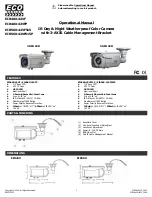
9
Framesize
Select the frame size of each JPEG or H.264
screen.
[Encoder
No.1 settings:
R
1920
´
1080, 1280
´
960,
1280
´
720, 720
´
480, 640
´
480, 640
´
360,
352
´
240, 320
´
240]
[Encoder
No.2 settings: 1920
´
1080, 1280
´
960,
1280
´
720, 720
´
480,
R
640
´
480, 640
´
360,
352
´
240, 320
´
240]
[Encoder
No.3 settings: 720
´
480,
R
640
´
480,
640
´
360, 352
´
240, 320
´
240]
9
Framerate
Select a frame rate.
[Encoder
No.1, Encoder
No.2 and Encoder
No.3
settings:
R
30 fps, 25 fps (not selectable for JPEG),
15 fps, 10 fps, 7.5 fps, 5 fps, 3 fps, 2 fps, 1 fps]
9
Bitrate (when “H.264 Baseline” or “H.264
High” is selected)
Select whether to set the scalable rate control
method for each encoder to CBR (Constant Bit
Rate) or VBR (Variable Bit Rate).
0
CBR:
Data is encoded at a fixed bit rate regardless of
the condition of input video signals. It is easy to
estimate the bit rate. Select from the list of bit
rate ranges.
0
VBR:
The bit rate varies according to the condition of
input video signals. The picture quality is stable
but it is difficult to estimate the bit rate. Select
from the list of bit rate ranges.
[Encoder
No.1, Encoder
No.2 and Encoder
No.3
settings:
R
CBR, VBR]
[Bitrate range: 64, 128, 256, 384, 512, 768, 1024,
1536, 2048, 3072, 3584,
R
4096, 8192] kbps
Memo :
0
When “VBR” is set, the [Bitrate] setting uses
30 fps as a reference value.
When the frame rate is low, the actual bitrate
distributed may drop.
Example: When the frame rate is 15 fps and the
I-frame interval is 15 frames, specifying the
bitrate as 8192 kbps gives a maximum bitrate of
about 4000 kbps. (When the frame rate is below
30 fps, the extent to which the maximum bitrate
drops is dependent on the frame rate and the
I-frame interval.)
9
I Frame Interval (when “H.264 Baseline” or
“H.264 High” is selected)
Encoding starts from the I-frame. Shortening the
interval stabilizes the picture quality even when
there are rapid changes in the video image.
However, the picture quality for images with little
change will deteriorate.
[Encoder
No.1, Encoder
No.2 and Encoder
No.3
settings: 5, 10, 15,
R
30, 60, 90, 120] frames
9
Quality (when “JPEG” is selected)
Selects the JPEG picture quality (scalable rate
control method) and picture quality level.
0
AFS:
Encoding is performed such that the target file
size is the average size of multiple JPEG
images.
0
VFS:
The quantization table during JPEG encoding
will be maintained and the file size will increase
or decrease according to the input signals.
When recording JPEG data to a recorder with a
limited storage capacity, the maximum
recording time may vary as the file size
fluctuates under this setting.
[Encoder
No.1, Encoder
No.2 and Encoder
No.3
settings: AFS,
R
VFS]
[Encoder
No.1 picture quality level: Level
1 to
R
Level
7]
[Encoder
No.2 and Encoder
No.3 picture quality
level: Level
1 to
R
Level
4 to Level
7]
Note :
0
H.264 Baseline cannot be set for multiple
encoders at the same time. Only one channel
can be set with a frame size of 1280
´
720 or
lower and a bit rate of 1.5 Mbps or lower. If the
setting you have selected exceeds these limits,
a message will appear when you press the [OK]
button.
Memo :
0
You can specify the file size by combining the
frame size and the picture quality level.
0
Select between Level
1 and 7. The picture
quality increases when the level value is small.
However, the file size increases.
0
The reference value per frame is displayed to
the right of the picture quality setting pull-down
menu.
0
During multi-encoding, there is a limit to the total
number of pixels per unit time that can be
encoded simultaneously by three encoders
(total frame size and frame rate processed by
each encoder).
p.114 [Appendix (Restrictions during
54
[Advanced Settings] Page - [Encoding] Page
Se
tti
ng
Us
in
g In
ter
net
E
xplor
er
















































